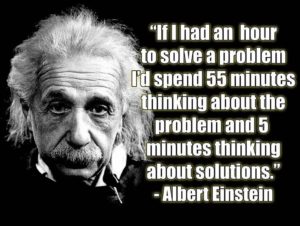Business Process Improvement – Getting Started

After you have read and understand the overview of what Business Process Improvement is, you can start to think about how it can positively impact your organization. Even though business process improvement and continuous improvement have many tools and processes you could use, the list below is a simple way to get you started.
- Select the problem area or process to address. Believe it or not, this is one of the most important steps. Is it a problem worth solving? Will it positively impact your business?
- Plot your potential improvement areas. If you have several areas you want to improve, prepare a piece of paper in a 2×2 matrix that looks like this below. Evaluate each potential improvement area based on if it will have a high or low impact on the business and if it will take a high or low effort to make it happen. Plot your potential improvement areas in one of these four quadrants. This will give you guidance on how to prioritize the areas to be improved. For example, if it’s going to have a minimal impact on your business but take a lot of energy and resources to address, then there may be more important problems to address first.

2) Gain alignment on the objective of what you need to improve.
Nothing is worse than getting half way through your improvement efforts only to realize that everyone is not on the same page about why you are trying to improve. Sometimes the objectives are “assumed”, and we all know what that leads to. Instead, get the leaders in the group to agree upon the objectives, and then hold to them.
3) Map out the process you want to focus on.
Try to capture (at a high level) the associated steps in the process that you are trying to improve. Be sure to include the people who are actually involved in the work so that you can best identify what these steps are currently. You will be amazed at the amount of good discussion that takes place when you do this. Many times, the group does not actually know all that is actually involved and in what sequence. This discussion will, at times, reveal the fact that there are inconsistencies with how the work gets done.
One of the most important things about this step is to make it visual by putting it up on the wall for the group to see. (Hint: Post-it notes come in very handy here because they can be easily moved around as necessary.) Be prepared that you may uncover other areas that need to be improved as well. However, resist the urge to be distracted by them at this point. Write them down to be addressed later.
4) Evaluate & brainstorm potential solutions.
After you have captured the steps in the process, it is time to brainstorm around potential ways to improve the process. It is extremely beneficial to have the people involved who are actually doing the work. As you are looking at potential solutions, ask such questions as:
- Where is there waste in our process?
- What steps can be eliminated or combined?
- What steps can be done be parallel?
- What steps can shortened?
- Where do we need better training?
- Where can we completely change the step itself?
After you have brainstormed potential new solutions, direct your team to select the ones they would like to pursue further.
5) Try your solutions.
After the team has selected potential solutions, now it is time to try them out. Take the opportunity to quickly test your solution(s) to see if it delivers the results you were hoping for. It is possible at this point that you may need to modify what you are trying out, and that is definitely OK. Iterations are always good if you are learning what will and won’t work.
6) Make changes and train.
Once you feel that this solution is a good fix to the problem you had originally scoped, go ahead and document what you are changing so that everyone is on the same page. Make sure all of the appropriate people are trained on this new process and know what is to be expected.
7) Monitor your changes.
The last point is critical. Nothing is more frustrating than spending your valuable time and energy to improve something, and it doesn’t last. Monitor closely the changes you put in place, and hold the team accountable for maintaining the changes that you made.
Use these seven steps to work on improving your internal processes. Before you know it, you’ll be working more efficiently, and everyone will thank you for it.
